 However, some of my new roses are going to be contenders. Tradescant is blooming its head off in the 100+ heat, bearing deep red blooms that are textured like butterfly wings. And Pat Austin (left) isn't stingy with its glowing orange/yellow/blush flowers.
However, some of my new roses are going to be contenders. Tradescant is blooming its head off in the 100+ heat, bearing deep red blooms that are textured like butterfly wings. And Pat Austin (left) isn't stingy with its glowing orange/yellow/blush flowers.
Sunday, July 16, 2006
Favorite roses
Right now, my favorite rose is Reine des Violettes, a Hybrid Perpetual that has fuschia/violet colored blooms, hardly any thorns and a true-rose fragrance. Even the foliage is fragrant so when I deadhead it my hands smell seriously wonderful.
 However, some of my new roses are going to be contenders. Tradescant is blooming its head off in the 100+ heat, bearing deep red blooms that are textured like butterfly wings. And Pat Austin (left) isn't stingy with its glowing orange/yellow/blush flowers.
However, some of my new roses are going to be contenders. Tradescant is blooming its head off in the 100+ heat, bearing deep red blooms that are textured like butterfly wings. And Pat Austin (left) isn't stingy with its glowing orange/yellow/blush flowers.
 However, some of my new roses are going to be contenders. Tradescant is blooming its head off in the 100+ heat, bearing deep red blooms that are textured like butterfly wings. And Pat Austin (left) isn't stingy with its glowing orange/yellow/blush flowers.
However, some of my new roses are going to be contenders. Tradescant is blooming its head off in the 100+ heat, bearing deep red blooms that are textured like butterfly wings. And Pat Austin (left) isn't stingy with its glowing orange/yellow/blush flowers.
Saturday, July 15, 2006
Container gardening in the desert
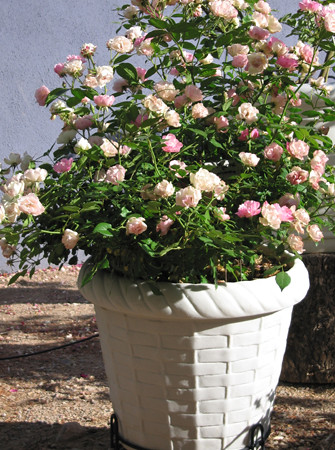 When I had my open garden this spring people were surprised that many of my roses were in pots. Ever since then I have wanted to write about my observations about using pots in the desert.
When I had my open garden this spring people were surprised that many of my roses were in pots. Ever since then I have wanted to write about my observations about using pots in the desert.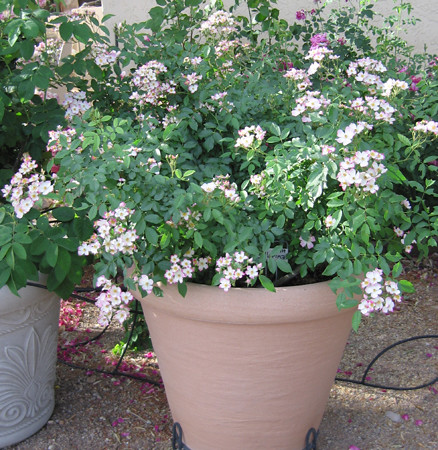 CONS: It is true that roots dry out and get hot faster for plants in pots. Additionally, our winds here in Tucson have knocked over many of my larger roses and damaged their canes and root systems. And finally, potted plants must be re-potted every 3-4 years when the soil line shrinks because of loss out the bottom and compaction. That isn't a problem with small plants but it is not fun to pull a 10 ft. rose out of its pot. Some gardening books will also tell you that you need to fertilize more often and that it is impossible to mulch but I have not found this to be true.
CONS: It is true that roots dry out and get hot faster for plants in pots. Additionally, our winds here in Tucson have knocked over many of my larger roses and damaged their canes and root systems. And finally, potted plants must be re-potted every 3-4 years when the soil line shrinks because of loss out the bottom and compaction. That isn't a problem with small plants but it is not fun to pull a 10 ft. rose out of its pot. Some gardening books will also tell you that you need to fertilize more often and that it is impossible to mulch but I have not found this to be true. 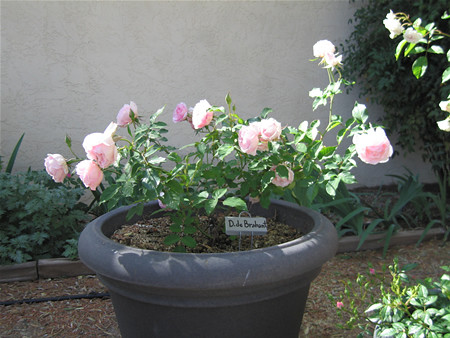 PROS: Pots allow you to move a plant that needs more protection from the wind or sun, as well as to control the quality of its soil more easily (our native soil is dreadful for roses). Re-potting lets you check the health of a plant's root system: I have discovered crown gall and grub infestations during the repotting process. And finally, if you have large aggressive trees it is easier to protect the plants from root competition. Many of Tucson's most experienced Rosarians (Les, Terry, Lou and Judy) also keep their roses in pots, so I am in good company.
PROS: Pots allow you to move a plant that needs more protection from the wind or sun, as well as to control the quality of its soil more easily (our native soil is dreadful for roses). Re-potting lets you check the health of a plant's root system: I have discovered crown gall and grub infestations during the repotting process. And finally, if you have large aggressive trees it is easier to protect the plants from root competition. Many of Tucson's most experienced Rosarians (Les, Terry, Lou and Judy) also keep their roses in pots, so I am in good company.Here's what I have developed as "best practices" for my yard:
About the pots
Use light-colored synthetic pots of good size. True terracotta is lovely but it is too porous and dries out too easily. I have my cacti and succulents in terracotta and my roses in plastic or foam pots.
--New roses are in pots that are 6-8 inches across.
--Mature miniatures and patio roses are in pots 8-12 inches across.
--Standard roses and climbers are in 20-24 inch pots.
I learned the hard way that the cheapest pots that the hardware stores sell (thin plastic usually colored beige, green or terracotta) sun-rot in about a year. They're just not worth the money in the long-run. On the other hand, all of my foam, thick plastic or double-walled pots have lasted for 7 years and counting.
About the soil
I like Uni-gro potting soil which doesn't have a whole lot of pricey additives, but just the right amount of peat and vermiculite. To this I will add triple super-phosphate and occasionally Epsom salts to aid root growth. I try to get a soil line about 1 inch from the rim to allow for mulch.
To protect from tree roots and cut down on sow bugs and crickets many of my roses are slightly raised above the ground on plant trivets. An added plus is that the antelope squirrels and lizards love the cool shade under the roses.
My garden is totally organic, and it gets better every year. Every year I notice more lacewings, crab spiders and lady bugs and fewer aphids and white flies. Most of the damage to my roses these days is caused by pack rats and quail (quail eat the young growth but only in the spring when they are laying their eggs). We trap the rats and tolerate the rest.
Wednesday, July 05, 2006
Gold Rush backcountry trip
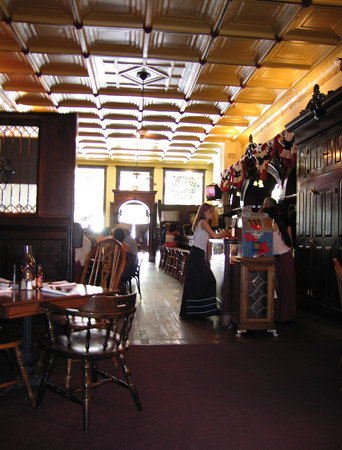 Just back from a long weekend exploring Prescott and the Bradshaw Mountains. The weather was absolutely perfect: cool, cloudy days, light rain showers, and evenings that got down to the low 60s. Just the tonic we needed in the middle of a Tucson summer!
Just back from a long weekend exploring Prescott and the Bradshaw Mountains. The weather was absolutely perfect: cool, cloudy days, light rain showers, and evenings that got down to the low 60s. Just the tonic we needed in the middle of a Tucson summer!Today we took the Senator Highway through the gold rush country, driving down the road that the stagecoaches traveled from Prescott to the mining camps in the Bradshaw Mountains. Most of the towns have left no trace; it is likely the stones and lumber were scavenged and used elsewhere. We drove through Palace Station (1875), Goodwin (1882), Bradshaw City (1863), Crown King (1888), Cleator (1901) and Bumblebee (1879).
 At Palace Station the stage coach stop is still there, a simple log cabin with a huge apple tree out front. At Goodwin I found 2 building foundations and something even more precious: a rose bush that I think was part of a settler's garden. At first I thought it was the wild mountain rose, Rosa woodsii, but then I realized that the thorns were all wrong and that there was also mint growing nearby. I dug up two pieces that had suckered and we'll see if they survive a Tucson summer.
At Palace Station the stage coach stop is still there, a simple log cabin with a huge apple tree out front. At Goodwin I found 2 building foundations and something even more precious: a rose bush that I think was part of a settler's garden. At first I thought it was the wild mountain rose, Rosa woodsii, but then I realized that the thorns were all wrong and that there was also mint growing nearby. I dug up two pieces that had suckered and we'll see if they survive a Tucson summer.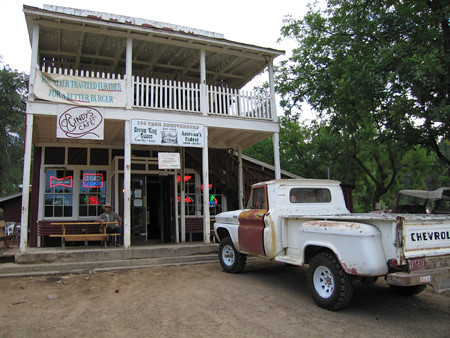 Crown King was a real hoot. It was the site of Arizona's richest gold mine and so prosperous that by late 1897 it had a post office, a company store, several saloons, two Chinese restaurants, and a feed yard. We expected it to be fairly modern and all commercialized, but it was the real thing! Crown King still has the state's oldest standing saloon and brothel, today a saloon and cafe. I was tickled by the sign on the door: "Friday and Saturday nights: Dogs cannot be in the Saloon after 8:00 p.m. due to prior dog fights / bites. All other times they must be on leash." We had our dog Arrow with us and he was totally welcome inside, as were several local dogs: Atlas, Scruffy and Kisses.
Crown King was a real hoot. It was the site of Arizona's richest gold mine and so prosperous that by late 1897 it had a post office, a company store, several saloons, two Chinese restaurants, and a feed yard. We expected it to be fairly modern and all commercialized, but it was the real thing! Crown King still has the state's oldest standing saloon and brothel, today a saloon and cafe. I was tickled by the sign on the door: "Friday and Saturday nights: Dogs cannot be in the Saloon after 8:00 p.m. due to prior dog fights / bites. All other times they must be on leash." We had our dog Arrow with us and he was totally welcome inside, as were several local dogs: Atlas, Scruffy and Kisses.The road back to I-10 took the path of the 1890s railroad (Murphy's Impossíble Railroad, aka Prescott and Eastern Railroad) so I tried to imagine taking the trip by train. At least it kept my mind off the roughness of the dirt road =).
The trip took a lot longer than we expected: 6 hours (including our picnic at Goodwin) to Crown King and 2 hours from Crown King to the highway. All on dirt roads, but some of the prettiest scenery I've seen in a long time.
8/2: My "Goodwin Mystery Rose" has rooted! Yeah!
Subscribe to:
Posts (Atom)